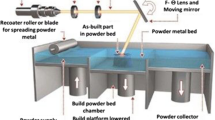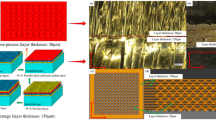Abstract
In this study, welding and forming defects in a deep drawing process of laser-welded blanks (LWBs) are investigated both experimentally and numerically. LWB is used to achieve minimum distortion and desirable weld quality. However, some unfavorable residual stresses are added throughout the forming operations, which decrease the lifetime of LWBs. The objective of this study is to estimate the effect of five significant process parameters on forming defects during the welding and forming of LWBs. To this end, the hole-drilling method is utilized to determine experimentally the residual stresses in diverse zones of LWBs. Besides, the laser beam welding and forming processes are simulated by SIMUFACTTM package and ABAQUSTM software, respectively. The validation results show that the proposed model is very promising to estimate residual stresses for LWBs in industrial parts, especially in automobile industries. Studying the effect of varying process factors, it is noticed that the joining quality of the weld region is enhanced by applying the high-level spot size which has an optimum range to prevent the probability of brittle crack.
Graphical Abstract

















Similar content being viewed by others
Data Availability
All data, material, and codes used in this paper are available.
References
Aminzadeh A, Karganroudi SS, Barka N, El Ouafi A (2021) A real-time 3D scanning of aluminum 5052-H32 laser welded blanks; geometrical and welding characterization. Mater Lett 296:129883
Javid Y, Ghoreishi M (2017) Thermo-mechanical analysis in pulsed laser cladding of WC powder on Inconel 718. Int J Adv Manuf Technol 92:69–79
Javid Y, Ghoreishi M (2012) Thermo-mechanical analysis of the laser welding of stainless steel 304. Lasers Eng (Old City Publ;23.
Javid Y, Ghoreishi M, Torkamany MJ (2016) Laser cladding of WC onto Inconel 718 super alloy: parametric study and physical properties. Lasers Eng (Old City Publ;34.
Faria C, Magalhães J, Blanco V, Peixinho N, Costa S (2019) Study on forming tool module with variable stiffness blank-holder for applications in high strength steel and laser welding parts. Mater Des Appl. II, Springer; p. 509–16.
Yang L, Guan Y, Gao A, Duan Y, Yao D, Li M (2019) Optimization of multi-objective quality of TWBs square box deep-drawing process parameters. J Braz Soc Mech Sci Eng 41:169
Xu F, Sun G, Li G, Li Q (2014) Experimental investigation on high strength steel (HSS) tailor-welded blanks (TWBs). J Mater Process Technol 214:925–935. https://doi.org/10.1016/j.jmatprotec.2013.11.018
Leitao C, Zhang BK, Padmanabhan R, Rodrigues DM (2011) Influence of weld geometry and mismatch on formability of aluminium tailor welded blanks: numerical and experimental analysis. Sci Technol Weld Join 16:662–668
Vasudevan V, Bandyopadhyay K, Panda SK (2014) Influence of anisotropy parameter on deep drawing of tailor welded blanks of low-carbon steels. Proc Inst Mech Eng Part B J Eng Manuf 228:1162–1171. https://doi.org/10.1177/0954405413506588
Narsimhachary D, Bathe RN, Padmanabham G, Basu A (2014) Influence of temperature profile during laser welding of aluminum alloy 6061 T6 on microstructure and mechanical properties. Mater Manuf Process 29:948–953
Pascu A, Stanciu EM, Voiculescu I, Tierean MH, Roatua IC, Ocaña JL (2016) Chemical and mechanical characterization of AISI 304 and AISI 1010 laser welding. Mater Manuf Process 31:311–318
Aminzadeh A, Parvizi A, Moradi M (2020) Multi-objective topology optimization of deep drawing dissimilar tailor laser welded blanks; experimental and finite element investigation. Opt Laser Technol 125:106029. https://doi.org/10.1016/j.optlastec.2019.106029
Javid Y (2020) Multi-response optimization in laser cladding process of WC powder on Inconel 718. CIRP J Manuf Sci Technol 31:406–417. https://doi.org/10.1016/j.cirpj.2020.07.003
Liu QS, Mahdavian SM, Aswin D, Ding S (2009) Experimental study of temperature and clamping force during Nd: YAG laser butt welding. Opt Laser Technol 41:794–799
Reddy BL, Reddy PR, Rao BCK (2013) A review on residual stresses in deep drawing. Int J Innov Res Sci Eng Technol 2:802–804
Kardan M, Parvizi A, Askari A (2018) Influence of process parameters on residual stresses in deep-drawing process with FEM and experimental evaluations. J Braz Soc Mech Sci Eng 40:157
Kardan M, Parvizi A, Askari A (2018) Experimental and finite element results for optimization of punch force and thickness distribution in deep drawing process. Arab J Sci Eng 43:1165–1175
Arif AFM, Al-Omari AS, Al-Nassar Y (2012) Development of residual stress during manufacturing of spiral welded pipes. Mater Manuf Process 27:738–745
Aminzadeh A, Parvizi A, Safdarian R, Rahmatabadi D (2020) Comparison between laser beam and gas tungsten arc tailored welded blanks via deep drawing. Proc Inst Mech Eng Part B J Eng Manuf 235:673–688. https://doi.org/10.1177/0954405420962391
Vasantharaja P, Maduarimuthu V, Vasudevan M, Palanichamy P (2012) Assessment of residual stresses and distortion in stainless steel weld joints. Mater Manuf Process 27:1376–1381
Olabi AG, Benyounis KY, Hashmi MSJ (2007) Application of response surface methodology in describing the residual stress distribution in CO2 laser welding of AISI304. Strain 43:37–46
Ye C, Telang A, Gill AS, Suslov S, Idell Y, Zweiacker K, Wiezorek JMK, Zhou Z, Qian D, Mannava SR, Vasudevan VK (2014) Materials Science & Engineering A Gradient nanostructure and residual stresses induced by ultrasonic nano-crystal surface modification in 304 austenitic stainless steel for high strength and high ductility. Mater Sci Eng A 613:274–288. https://doi.org/10.1016/j.msea.2014.06.114
Dias JS, Chuvas TC, Cindra Fonseca MDP (2016) Evaluation of residual stresses and mechanical properties of if steel welded joints by laser and plasma processes. Mater Res 19:721–727. https://doi.org/10.1590/1980-5373-MR-2015-0558
Kapadia P, Davies C, Pirling T, Hofmann M, Wimpory R, Hosseinzadeh F, Dean D, Nikbin K (2017) Quantification of residual stresses in electron beam welded fracture mechanics specimens. Int J Solids Struct 106–107:106–118. https://doi.org/10.1016/j.ijsolstr.2016.11.028
Abburi Venkata K, Dey S, Coules HE, Truman CE, Pirling T (2017) Assessment of the effect of residual stresses in elastic-plastic fracture of dissimilar welded components. Mater High Temp 34:492–499. https://doi.org/10.1080/09603409.2017.1378965
Jung SH, Lee T, Song SW, Kwon YJ, Kang H, Chae D et al (2017) Enhanced resistance to delayed cracking in deep-drawn lean duplex stainless steel: the role of residual stress. Korean J Met Mater 55:544–549. https://doi.org/10.3365/KJMM.2017.55.8.544
Yilbas BS, Arif AFM, Aleem BJA (2010) Laser welding of low carbon steel and thermal stress analysis. Opt Laser Technol 42:760–768
Liu S, Kouadri-Henni A, Gavrus A (2017) Numerical simulation and experimental investigation on the residual stresses in a laser beam welded dual phase DP600 steel plate: thermo-mechanical material plasticity model. Int J Mech Sci 122:235–243. https://doi.org/10.1016/j.ijmecsci.2017.01.006
Chin K, Lee S (2017) Communication residual stress effect on the delayed steels. Metall Mater Trans A 48:2692–2696. https://doi.org/10.1007/s11661-017-4056-3
Luca L, Luca TO (2019) Ishikawa diagram applied to identify causes which determines bearings defects from car wheels. IOP Conf Ser Mater Sci Eng 564:12093
Casalino G, Moradi M, Moghadam MK, Khorram A, Perulli P (2019) Experimental and numerical study of AISI 4130 steel surface hardening by pulsed Nd: YAG laser. Materials (Basel) 12:3136
Moradi M, Ghorbani D, Moghadam MK, Kazazi M, Rouzbahani F, Karazi S (2019) Nd: YAG laser hardening of AISI 410 stainless steel: microstructural evaluation, mechanical properties, and corrosion behavior. J Alloys Compd 795:213–222
Standard A (2004) E8," Standard test methods for tension testing of metallic materials. Annu B ASTM Stand 3:57–72.
PA. ASTM A945 / A945M-16, Standard specification for high-strength low-alloy structural steel plate with low carbon and restricted sulfur for improved weldability, formability, and toughness, ASTM International, West Conshohocken. 2016.
Standard A. E837-08 Standard test method for determining residual stresses by the hole-drilling strain-gage method. ASMT Int West Conshohocken, PA 2008.
Scafidi M, Beghini M, Bertoni L, Santus C (2016) The hole-drilling strain gauge method for the measurement of uniform or non-uniform residual stresses
Zhan Y, Zhang E, Ge Y, Liu C (2018) Residual stress in laser welding of TC4 titanium alloy based on ultrasonic laser technology. Appl Sci 8:1997
Aminzadeh A, Karganroudi SS, Barka N (2020) A novel approach of residual stress prediction in ST-14/ST-44 laser welded blanks; mechanical characterization and experimental validation. Mater Lett 129193
Nejatbakhsh H, Khataei M, Poursina M (2011) Prediction of fracture in deep drawing process, using ductile damage criteria. AIP Conf Proc 1383:477–483
Liu D, Li Y, Liu H, Wang Z, Wang Y (2018) Numerical investigations on residual stress in laser penetration welding process of ultrafine-grained steel. Adv Mater Sci Eng 2018:1–12
Singh A, Basak S, PS LP, Roy GG, Jha MN, Mascarenhas M et al (2018) Prediction of earing defect and deep drawing behavior of commercially pure titanium sheets using CPB06 anisotropy yield theory. J Manuf Process 33:256–267
Irthiea I (2019) Experimental and numerical evaluation of micro flexible deep drawing technique using floating ring. J Manuf Process 38:556–563
Hosford WF, Caddell RM (2011) Metal forming: mechanics and metallurgy. Cambridge University Press
Demirkesen S (2021) From Lean Manufacturing to lean construction: how principles, tools, and techniques evolved. Lean Manuf., IntechOpen
Moraitis GA, Labeas GN (2008) Residual stress and distortion calculation of laser beam welding for aluminum lap joints. J Mater Process Technol 198:260–269
Rahmatabadi D, Hashemi R, Tayyebi M, Bayati A (2019) Investigation of mechanical properties, formability, and anisotropy of dual phase Mg--7Li--1Zn. Mater Res Express 6:96543
Karbasian H, Tekkaya AE (2010) A review on hot stamping. J Mater Process Technol 210:2103–2118
Author information
Authors and Affiliations
Contributions
The authors’ contributions are as following: AA conceived, planned, and carried out data curation, methodology, software, formal analysis, and writing the original manuscript; SSK contributed actively in data curation, developing methodology, experimental and numeric analyses, and writing the manuscript; NB contributed in supervision, writing, review, and editing the manuscript; all authors provided critical feedback and helped shape the research, analysis, and manuscript.
Corresponding author
Ethics declarations
Ethical approval
This article does not involve human or animal participation or data; therefore, ethics approval is not applicable.
Consent to participate
This article does not involve human or animal participation or data; therefore, consent to participate is not applicable.
Consent for publication
This article does not involve human or animal participation or data; therefore, consent to publication is not applicable.
Competing interests
The authors declare no competing interests.
Additional information
Publisher’s note
Springer Nature remains neutral with regard to jurisdictional claims in published maps and institutional affiliations.
Rights and permissions
About this article
Cite this article
Aminzadeh, A., Sattarpanah Karganroudi, S. & Barka, N. Experimental and numerical investigation of forming defects and stress analysis in laser-welded blanks during deep drawing process. Int J Adv Manuf Technol 117, 1193–1207 (2021). https://doi.org/10.1007/s00170-021-07767-z
Received:
Accepted:
Published:
Issue Date:
DOI: https://doi.org/10.1007/s00170-021-07767-z




